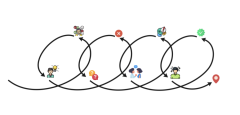Smith, K., 2021. Bauhaus Color Theory. [online] Sensational Color. Available at: <https://www.sensationalcolor.com/bauhaus-color/> [Accessed 23 June 2021].
Miller, R.B. (2014). Wassily Kandinsky’s Symphony of Colors | Denver Art Museum. [online] www.denverartmuseum.org. Available at: https://www.denverartmuseum.org/en/blog/wassily-kandinskys-symphony-colors [Accessed 20 Jun. 2021].
Listening In (2019). What’s the Sound of Colour? Kandinsky and Music. [online] www.youtube.com. Available at: https://www.youtube.com/watch?v=2xDnxkzQtdI&feature=emb_imp_woyt [Accessed 23 Jul. 2021].
One of the most enduring influences, though, is the Bauhaus colour theory that was taught under four prominent artists. The contributions of Johannes Itten, Wassily Kandinsky, Paul Klee, and Josef Albers undergird much of what we currently understand and believe about colour, and an examination of the teachings of these four artists helps us understand not only the formation of modern colour theory but indeed how colour theory is developed and transmitted.
Wassily Kandinsky, the Russian painter best known for his bold, geometric abstract works, taught at the Bauhaus from 1922 until it closed in 1933. He considered colour to be an utterly transcendent language of sorts, a way to examine the universal aesthetic. He adopted a synesthetic relationship with colour, associating particular colours with both specific geometric shapes and with musical tones and chords. Yellow, for example, was best expressed as a triangle and was the colour expressed by a middle C played on a brassy trumpet. Circles were blue, and the colour black in musical terms was the colour of closure. The examination of colour in terms of the fullness of its expression is certainly one of Kandinsky’s legacies.
